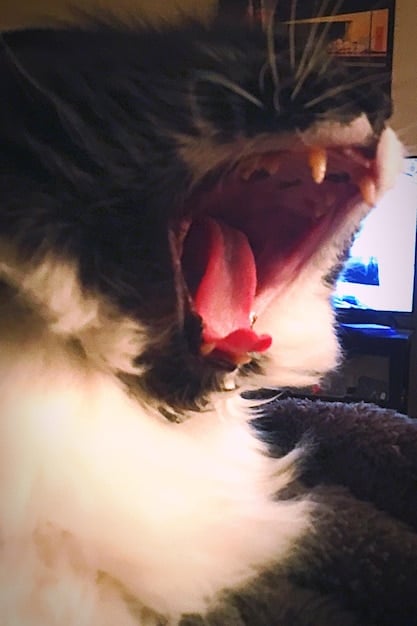Why Is My Cat Suddenly Aggressive? Understanding Feline Aggression in 2025

Sudden aggression in cats in 2025 can stem from various underlying issues, including medical conditions, environmental stressors, fear, pain, or changes in household dynamics, requiring careful observation and veterinary consultation to identify and address the root cause.
Discovering that your feline friend has suddenly become aggressive can be concerning. Why is my Cat Suddenly Aggressive? Understanding and Addressing Feline Behavioral Changes in 2025 requires a deep dive into potential triggers and effective solutions to restore peace in your home.
Unraveling the Mystery: Sudden Aggression in Cats
Cats are known for their complex behavior, so sudden aggression can be alarming. Often, it’s a sign of something deeper, whether physical discomfort or environmental stress. Understanding the potential causes is the first step in helping your feline companion.
Medical Causes of Aggression
A cat’s sudden aggression might be linked to an underlying medical condition. Pain or discomfort can make a cat irritable and more likely to lash out. Dental problems, arthritis, or even neurological issues can be the culprit.
Environmental Stressors
Changes to the cat’s environment can lead to stress and aggression. Moving to a new home, introducing a new pet, or even rearranging furniture can disrupt a cat’s routine and sense of security.
- New pet in the household
- Changes in the daily routine
- Loud noises or construction
- Lack of personal space
Addressing these potential causes promptly can significantly improve your cat’s behavior and overall well-being. Ignoring these signs can lead to escalated aggression and a decline in your cat’s quality of life.
Decoding Different Types of Feline Aggression
Not all aggression is the same. Cats display aggression in various forms, each with its own triggers and solutions. Identifying the specific type of aggression your cat is exhibiting is crucial for effective intervention.
Fear-Based Aggression
Fear aggression often arises from a perceived threat. Your cat may display defensive behaviors such as hissing, swatting, or biting to protect themselves. Loud noises, unfamiliar people, or other animals can trigger this response.
Territorial Aggression
Territorial aggression can occur when a cat feels their space is being invaded. This is particularly common in multi-cat households or when a new pet is introduced. Cats may exhibit behaviors such as stalking, chasing, or fighting to defend their territory.
Understanding the root cause of aggression helps in tailoring interventions to address the specific needs of your cat effectively.

Pinpointing the Root Cause: Why the Sudden Change?
Understanding **why is my cat suddenly aggressive?** involves exploring a variety of factors to uncover the root cause of the behavior change. The onset of aggression can be traced to specific environmental changes or underlying health challenges. Thorough investigation can make a significant difference.
Changes in Their Environment
Cats are creatures of habit, and any disruptions to their environment can trigger aggression. Changes ranging from rearranging furniture to introducing new individuals in the territory can cause discomfort. Identifying these specific changes is the first step toward creating a more stable environment.
Underlying Health Issues
Sudden aggressive behavior can often indicate hidden health issues or discomfort. Conditions such as arthritis, dental problems, or infections can cause irritability and aggressiveness. Veterinary examination is essential in determining if health problems are contributing to the issue.
- Arthritis and joint pain
- Dental problems such as tooth decay
- Hyperthyroidism
- Neurological conditions
Recognizing these changes and potential health issues is imperative for correctly diagnosing the causes of aggression. Seeking expert opinion and observation can positively influence the intervention.
Recognizing the Warning Signs Before Aggression Erupts
Identifying the subtle cues a cat gives before an aggressive outburst can help prevent incidents. Recognizing these signs allows you to intervene and redirect the cat’s attention before the situation escalates.
Body Language Cues
Cats communicate a lot through their body language. Flattened ears, a twitching tail, dilated pupils, and a tense posture are all signs that a cat is becoming agitated and may be preparing to strike. Recognizing these cues is key to defusing potential aggressive behavior.
Vocalization
Vocalizations such as hissing, growling, and spitting are clear indicators that a cat is feeling threatened or aggressive. These sounds are warnings that the cat is not comfortable with the situation and may escalate to physical aggression if the threat persists.

Steps to Take When Your Cat Becomes Aggressive
Knowing what steps to take when your cat displays aggressive behaviors is crucial for protecting both yourself and your pet. These steps include ensuring personal safety and modifying your cat’s environment.
Ensuring Personal Safety
When a cat is aggressive, it is important to prioritize your safety. Avoid direct physical contact with the cat and use barriers such as pillows or blankets to protect yourself. Move slowly and calmly to avoid startling the cat further.
Modifying the Environment
Making changes to your cat’s environment can help reduce stress and aggression. Provide multiple resources such as food bowls, water dishes, and litter boxes to eliminate competition. Create safe spaces where your cat can retreat when feeling overwhelmed.
- Providing plenty of vertical space
- Ensuring easy access to food and water
- Using pheromone diffusers
- Separating cats during feeding times
Taking proactive and appropriate actions can help de-escalate aggressive situations and improve your cat’s overall well-being. Consistently implementing these strategies can lead to long-term behavioral improvements.
Long-Term Strategies for Reducing Feline Aggression
Addressing sudden aggression in cats requires a long-term approach that focuses on both behavioral therapy and environmental management. This comprehensive strategy helps in creating a stable and comfortable environment to reduce the likelihood of aggressive outbursts.
Behavioral Therapy Techniques
Behavioral therapy can help modify your cat’s aggressive behaviors by teaching them new responses to triggers. Techniques such as counter-conditioning and desensitization can be effective in reducing fear and anxiety.
Environmental Enrichment
Enriching your cat’s environment can help reduce stress and boredom, which may contribute to aggression. Provide plenty of toys, scratching posts, and climbing opportunities to keep your cat mentally and physically stimulated.
A combined approach encompassing behavioral therapy and environmental enrichment is often necessary to tackle the underlying causes of feline aggression and guarantee lasting positive results.
| Key Point | Brief Description |
|---|---|
| 🩺 Medical Checkup | Rule out underlying health issues by consulting a vet. |
| 🏡 Environment Changes | Identify and address stressors such as new pets or loud noises. |
| 🐾 Behavioral Therapy | Use techniques like desensitization to reduce fear and anxiety. |
| 🧸 Enrichment | Provide toys, scratching posts, and climbing structures to reduce boredom. |
Frequently Asked Questions
▼
Sudden aggression can be due to fear, pain, or feeling threatened. Consider changes in the environment or health issues. A vet visit can help rule out medical causes.
▼
Use barriers like blankets or pillows to protect yourself. Avoid direct contact, and move slowly. Give the cat space, and seek professional help if the aggression persists.
▼
While less common, a poor diet can affect a cat’s mood and energy levels. Make sure your cat is receiving a balanced diet recommended by a vet. Discuss any dietary concerns with your veterinarian.
▼
Introduce them slowly with scent swapping and separate spaces. Supervise initial interactions, and provide plenty of vertical space for the cat to retreat if overwhelmed. Use positive reinforcement.
▼
Consult a vet if the aggression is sudden, severe, or accompanied by other symptoms. Medical issues could be the root cause. A vet can offer a complete diagnostic and treatment strategy.
Conclusion
Understanding **why is my cat suddenly aggressive?** involves considering several factors, including medical issues, environmental changes, and behavioral triggers. By taking a comprehensive approach that involves veterinary care, environmental modifications, and behavioral therapy, you can help your cat overcome their aggression and restore peace to your home.





